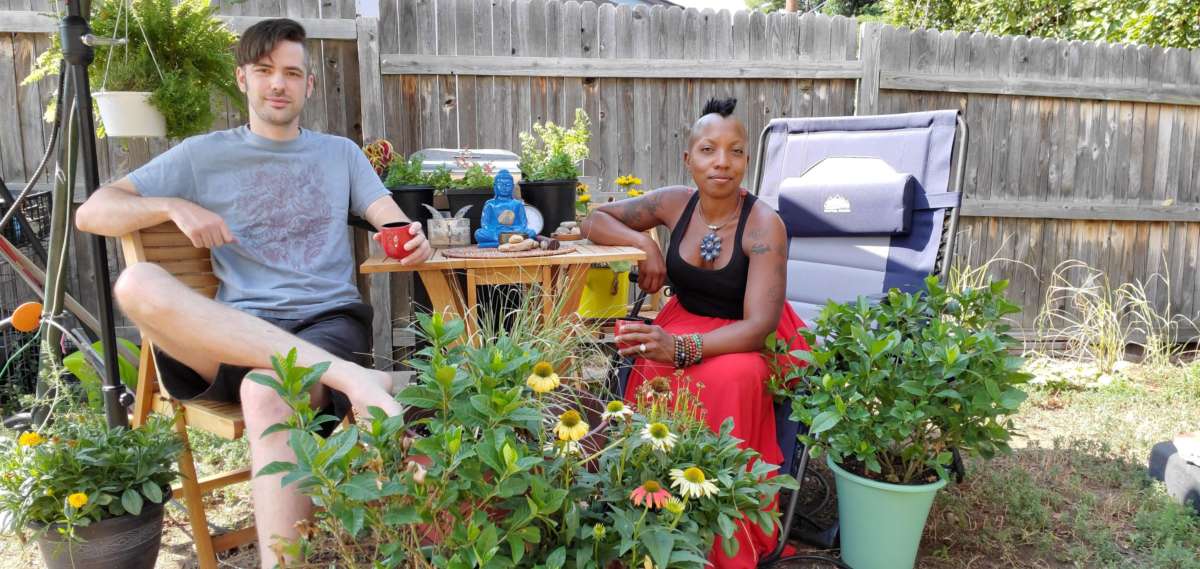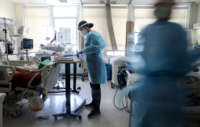
Quána Madison is diagnosed with multiple conditions that send pain coursing through her entire body on a daily basis. Madison is also a Black woman, and medical professionals don’t always believe her.
The pain became too much to bear on a summer day in 2017. Madison felt new pain and was unable to walk, so she checked into an emergency room near her home in Denver, Colorado. Before the visit was over, Madison says, she was assaulted, accused of “drug-seeking” and made to fear being arrested.
Madison has lived with chronic pain for years, but her pain worsened after she suffered a life-threatening complication from a preventive hysterectomy and oophorectomy performed after she was found to be at risk for cancer. By 2017, Madison was diagnosed with several chronic pain syndromes, including fibromyalgia and peripheral neuropathy, along with autoimmune diseases, depression, anxiety and post-traumatic stress disorder. Madison says she left a doctoral program after the school failed to provide accommodations. She often woke up screaming from pain in the middle of the night.
At the emergency room, a nurse arrived to draw a blood sample. Madison’s medical conditions make having blood drawn painful and, following the advice of a doctor she’d previously seen, Madison explained to the nurse that she may cry out. She requested a warm compress to ease the pain, but the nurse refused. The nurse tried multiple times to draw blood and failed. Madison was in tears, but she says the nurse was frustrated, gripping her arm tightly. Madison asked to see another nurse. The nurse, who was white, accused Madison of exaggerating her pain in order to get painkillers, an all-too-common experience among Black people seeking medical care. Madison took out her phone to record a video.

“I’ve learned as a Black woman that if I don’t record something or have a witness, I am not believed until I show the recording, and I’ve had to use that strategy multiple times to get basic care,” Madison said in an interview.
The nurse lunged for the phone as Madison began to record. Alarmed, Madison’s partner, who is white, attempted to calm the nurse down. The nurse announced that she was calling the police and left. A police officer arrived and began asking questions and Madison feared she was going to jail. The nurse told the officer that Madison was looking for drugs.
“All I could think of think was: I have to logically explain this step by step so I don’t get arrested. I was terrified that I was about to get arrested if [the officer] doesn’t believe me,” Madison said, adding that she never asked the nurse for painkillers. “I hadn’t even made it to, how are we going to manage my pain?”
Finally, a supervising doctor intervened and drew Madison’s blood himself. The police officer eventually left. Still in overwhelming pain that rendered her nearly immobile, Madison was told to find treatment somewhere else.
It wasn’t the first time Madison experienced racism in the medical system. After the hysterectomy and oophorectomy surgery, which involve the removal of the uterus and ovaries, Madison was left in extreme pain without receiving a painkiller for nearly two hours until she finally called a family member and begged them to contact the hospital. Afterwards, she was prescribed far fewer painkillers than white people she knows who underwent the same procedure, and she is routinely denied referrals to pain specialists.
Stories like Madison’s receive little attention in the media despite well-documented racism and bias against patients of color across the health care system, especially against Black, Latino and Indigenous patients. Years of research shows that Black (as well Latino and Asian) patients are far less likely to receive pain medication than white patients and are systematically undertreated for pain, often because providers wrongly believe Black people have a higher pain tolerance or suspect they are “drug seekers” abusing or selling painkillers. The latter racist bias, of course, is rooted in the war on drugs that has targeted Black communities for decades.
Black Overdose Deaths Spike
Around the same time that a nurse called the police on Madison, a team of researchers published a study comparing rates of fatal drug overdose between the white and Black populations. Starting in the early 1990s, painkiller prescribing became more liberal for white patients thanks to changes in medical thinking and marketing by pharmaceutical companies, the team reported, but prescribing remained low among Black patients. By 2010, the rate of fatal overdose involving opioids was twice as high among whites than Black people. Critics of “overprescribing” concluded that discrimination had spared an estimated 14,000 Black lives, even if Black patients were more likely to be left in agony by racist prescribers.
However, the federal data analyzed in this study is probably inaccurate and clearly does not tell the whole story. Overdoses are often the result of a combination of drugs, including alcohol, and errors on death certificate are very common. In 2018, analysts revealed that tens of thousands of deaths involving black market synthetics such as fentanyl and its analogues had been attributed to prescription drugs by the Centers for Disease Control (CDC). Last year, researchers concluded that the public was “misled” for more than a decade to believe that, as one White House report put it, “opiate overdoses, once almost always due to heroin use, are now increasingly due to abuse of prescription painkillers.”
While experts say pain pills did shape the crisis early on, particularly in whiter communities, rapid reductions in prescribing and the availability of crushable pills pushed users toward an increasing volatile heroin supply. Other measures were also taken. Oxycontin, for example, was reformulated to deter injection drug users. After 2010, rates of fatal overdose among Black and white people converged and continued to climb.
By 2018, as patients on long-term opioid therapy struggled to obtain medication or even see a doctor, many experts agreed that painkiller “overprescribing” was not causing the overdose crisis. The American Medical Association declared a “multi-factorial” crisis that could no longer be viewed through “a prescription opioid-myopic lens.” Overdose death rates among Black people more than doubled from 2011 to 2015, researchers noted, but the increase could not be explained by the “shift” from prescription painkillers to heroin seen in white communities.
Deep racial disparities in health care and a lopsided response to the overdose crisis are now associated with an alarming spike in death. The estimated number of fatal drug overdoses in the U.S. hit a record over the past year, surpassing 100,000 deaths — roughly a 30 percent increase over 2018-2019. Experts say the current approach to the crisis is not working, especially in communities of color.
A National Institutes of Health study released in September found that fatal overdoses among Black people across four states increased by 38 percent between 2018 and 2019 while there was little change among white people and other groups. In New York, overdose deaths declined by 18 percent for white people but stayed stable among the Black population, suggesting that Black patients did not benefit equally from addiction treatment and overdose prevention efforts.
“We must explicitly examine and address how structural racism affects health and leads to drug use and overdose deaths,” concluded Nora Volkow, director of the National Institute on Drug Abuse, said in a statement.
“Whitewashing” the Overdose Crisis
Over the past two decades, media outlets ran sensational stories about young people from whiter communities who were prescribed opioids and later became addicted to heroin. Although this is a real problem, and untreated trauma and mental illness have emerged as key indicators of addiction risk, research now shows that prescriptions are not the major drivers of addiction or overdose. Today, studies show the vast majority of people prescribed opioids under medical supervision do not overdose or become addicted, and most of today’s overdose victims are not yesterday’s patients.
Meanwhile, throughout the 2000s and beyond, media observers often drew a distinction between rural and suburban white people falling victim to pain pills and Black and Brown people injecting heroin in urban areas where a legitimate prescription is more difficult to obtain. The death of actor Philip Seymore Hoffman in 2014 “crystalized a decade of media fascination with the white prescription opioid cum heroin user,” according to a 2017 analysis by the Drug Policy Alliance. The narrative about innocent white people duped by the pharmaceutical industry is just the latest “whitewashing” of opioid-related issues.
The history of opioid consumption in the United States is cyclical; periodic increases in prescribing and use are followed by crackdowns and outcry. In the late 19th and early 20th centuries, white people who could afford medical care were considered “victims” if they became addicted to painkillers, according to a 2020 paper co-authored by Sarah Wakeman, a professor of medicine at Harvard. In the 1950s and 1960s, access to family doctors allowed the upper middle class to shift from opioids to sedative and stimulant pills that carried less stigma. Meanwhile, lower-income people, immigrants and people of color who informally accessed opioids for pain and other ailments were demonized and criminalized, a type of racism that escalated when President Nixon declared the “war on drugs” in 1970.
With white faces painted on the latest opioid scare, cops and lawmakers touted a more compassionate approach to addiction and began investing in treatment as an alternative to jail time, which leaves anyone dependent on opioids at extreme risk for overdose. President Obama tentatively embraced a “public health” approach. The Trump administration deployed similar rhetoric as law enforcement continued reducing the opioid supply. While programs remain limited and underfunded, and criminalization persists (and has even been heightened on some fronts), some policymakers began embracing harm reduction strategies such as improving access to medications that treat addiction and reverse overdoses. New York City recently announced the nation’s first legally sanctioned overdose prevention center, where people can use drugs under medical supervision and connect with services — a strategy proven to save lives.
Black activists saw a double standard. In the 1980s and 1990s, the media fixated on the “crack epidemic” in Black communities, and the escalating criminalization that followed filled streets with police and helped make the U.S. the most incarcerated nation on the planet. By 1995, one-third of young Black men in cities were entrapped in the criminal legal system and urban neighborhoods were cast as the epicenters of addiction. Harm reduction would not enter the mainstream conversation until authorities declared an “opioid epidemic” as the media covered prescription drug abuse in white communities.
Harm reduction and efforts to expand addiction treatment appeared to be helping in 2017 and 2018, when overdose deaths began to decline in some regions for the first time in years. Yet overdose death rates in Black and Latinx communities continued to rise across the country. Then the pandemic hit, isolating users from health supports, friends and family; 2020 would be the deadliest year on record.
The New Victims: Pain Patients
The opioid overdose wave has prompted a police crackdown, although its nature has been somewhat different from that of the “crack era.” Law enforcement fixates on “diversion,” the idea that prescription drugs are falling into the wrong hands — perhaps drug dealers or the “opioid naïve” white people portrayed in news stories. Thanks to a mix of regulation, electronic surveillance and old-fashioned drug raids on clinics and pharmacies that have terrified providers and put hundreds in prison, opioid prescribing plummeted by 60 percent over the last decade. The outgoing Trump administration declared that the “prescription opioid epidemic” is over, but the total number of drug overdose deaths more than doubled since 2011.
Prescription pills are much safer than street drugs, as potency is measured down to the milligram, making it easier for users to know how much they’re taking. Yet pharmacies in Black communities are less likely to carry painkillers than pharmacies in whiter areas, and discrimination in the job market has left Black patients with fewer insurance options to cover pain management and addiction treatment. Across the country, the Drug Enforcement Administration (DEA) has suspended or revoked pharmacy licenses for dispensing painkillers, and Black pharmacists say they are unfairly targeted.
“They treated me exactly like a criminal,” said Aaron Howard, a Black pharmacist in Florida who was raided by the DEA in 2018, in an interview.
The DEA claimed Howard failed to “resolve” so-called “red flags” for diversion when a handful of patients were prescribed more than one controlled substance and chose his small pharmacy over others located closer to their homes. The DEA regularly tracks the distance between a patient’s address and the pharmacy where they fill prescriptions, according to multiple DEA search warrants reviewed by Truthout, but most patients are unaware of this surveillance. Howard said he’s known the patients for years, and to his knowledge, they are still taking the medications as prescribed by their doctors.
Counterfeit pills are now common in the informal market, where people facing barriers to health care are known to seek relief. As police have aggressively pursued illegal heroin, traffickers have turned to potent synthetics that mimic heroin’s effects but can be transported in smaller packages. In some areas, low-level sellers improvise by mixing drugs into dangerous combinations when the supply of opioids runs short. At the same time, some drug dealers practice harm reduction to protect their clients by warning clients about strong batches, testing drugs for adulterants, and distributing test strips and other safety supplies. Experts say drug sellers are an under-utilized resource for preventing overdose.
We now know that today’s overdose crisis does not stem from prescriptions. People are dying from large and often combined doses of powerful synthetic opioids in the heroin and cocaine supply, as well as drugs ranging from alcohol to stimulants and benzodiazepines. In 2019, a study in Massachusetts found that only 1.3 percent of overdose victims had an active painkiller prescription. The study was small but became the latest source of vindication for pain patients who say they face discrimination and have lost access to painkillers because doctors and pharmacists operate in fear of law enforcement. Some say they can no longer function; others commit suicide.
The “don’t punish pain” movement is growing louder as policymakers reconsider controversial limits on prescribing and courts become increasingly skeptical of the myriad lawsuits accusing drug makers of creating the crisis with misleading advertising. (Other lawsuits were successful, of course, including the class-action case against Purdue Pharma, which aggressively pushed Oxycontin two decades ago and saw a judge overturn a $4.5 billion bankruptcy settlement protecting the Sackler family last week.) Many white pain patients are experiencing the impacts of drug policing for the first time, and they are angry about barriers to pain relief. According to the statistics, Black patients have always faced these barriers.
A Drug War Inside the Health System
There are no hard and fast rules in the overdose crisis; every drug user’s interactions (or lack thereof) with the medical and criminal legal systems are different. However, like Madison, Black and Brown people are more likely to be viewed as “addicts” or “criminals” rather than “patients.” A recent investigation across 21 states found that Black people were arrested for cocaine far more often than white people were arrested for opioids in 2016, and Black people were three to four times more likely to be arrested for opioids and all other drugs, despite similar rates of drug use across racial groups. Low-income people and pregnant people in particular also face intense stigma.
The drug war is now deeply embedded in the medical system. There are huge racial disparities in access to buprenorphine, a drug used to treat opioid addiction that can be obtained from a pharmacy. Studies show that buprenorphine, a gold standard for treating opioid addiction and preventing overdose, is most often prescribed to white patients with private health insurance. White patients diagnosed with substance use disorders are more than three times as likely to receive a buprenorphine prescription during a visit to the doctor than Black patients diagnosed with substance use disorders, according to the American Medical Association. Patients of color are more likely to receive methadone, the other gold standard, which is subject to intense state surveillance.
Before the pandemic, most methadone patients were required to show up in person to receive medication, creating barriers for low-income people and anyone without reliable transportation or a busy schedule. Emergency pandemic rule changes increased access to telehealth services and allowed patients to take medication home, and advocates are pushing to make these changes permanent. Still, methadone patients face red tape that most pain patients prescribed opioids do not, if they are lucky enough to have found a provider in the first place. Both methadone and buprenorphine are heavily scrutinized by police because they are also opioids, and doctors and pharmacies that provide buprenorphine have been shut down with no thought given to where patients will go next. Even as overdose deaths soar, doctors and pharmacies are wary of prescribing and dispensing life-saving medication.
Recently, states have set up databases tracking controlled-substance prescriptions from the doctor’s office to the patient’s home address. Bamboo Health, a company formerly known as Appriss, combined Prescription Drug Monitoring Databases (PDMPs) with a plethora of personal health data to develop Narxcare, an artificial intelligence system designed to alert doctors to “drug seeking” patients and those at risk of overdose. Reporting for Wired, journalist Maia Szalavitz revealed how Narxcare’s algorithms have a “disparate impact” on women and people of color, singling out those with complex health needs and histories of trauma and even sexual abuse.
According to the algorithm, trauma puts patients at higher risk of addiction, but advocates say prescribing decisions should be made by doctors and patients, not AI. Bamboo Health says its algorithms are not discriminatory, and the company clashed with Szalavitz after she reported that Appriss controls criminal records data that may be built into Narxcare, which could implicate people of color who are more likely to be targeted by police.
Regardless, experts say the effects of prescription surveillance are mixed. While PDMPs are associated with fewer prescription opioid-related overdoses in some states, the decrease is offset by an increase in deaths from heroin, according to Wakeman and other researchers. PDMPs do not address the “underlying social and political forces” that contribute to addiction and overdose, Wakeman wrote, and could push patients into the illicit drug market.
“It seems to target underprovided people who don’t have access or means in this country, and just hone in on them and punish them for it,” said Bev Schechtman, a researcher with The Doctor Patient Forum who worked with Szalavitz. “These are people who don’t have a lot of access to health care to begin with.”
The policing of pain follows drug war logic: If there’s a drug problem (i.e., overdoses), then attack the supply. If the number of overdoses is any metric, then this strategy is failing disastrously, advocates say, and its failures are falling hardest on Black communities. A close look at the data reveals that bias against prescribing opioids to Black patients, resulting in fewer prescriptions, did not spare Black lives in the long run. Instead, Black drug users — including those with untreated pain or addiction — were quickly exposed when the supply of Oxycontin and Percocet dried up and the heroin supply became cheaper and increasingly adulterated.
As current policies continue to fail, harm reduction efforts are calling for a “safe supply” of opioids, including prescription heroin for those at high risk of overdose.
“To address societal biases towards those with addiction, society needs to stop viewing addiction through a divided lens,” Wakeman’s team wrote. “Clinicians need to better frame addiction as a chronic illness that can affect all people, rather than as a chronic illness when it happens among socially privileged groups and a moral failing when it occurs among minorities and other marginalized groups.”
Without this necessary reframe, advocates say, the prescribing crackdown will continue to push doctors to discontinue chronic opioid therapy regardless of an individual patient’s needs — particularly in the case of Black patients and others on the margins. This puts patients at high risk for overdose.
“To be able to be monitored by a [doctor] … and work together, that makes it a lot easier to prevent problems, whether it be overdose or other complications,” Madison says. “But not being able to get pain management or treatment around it means that people will go to the black market, or have mental health crises that come into play.”
To combat racist practices in health care, Madison says individual providers must think carefully about their own racism and work to address it — but the work doesn’t stop there. Health care organizations must examine the history of medical racism and invest time and resources into understanding the lived experience of patients of color, activists emphasize. This process will take time.
“It’s not just checking off a checklist and saying, ‘OK now we’re done,’” Madison said.
Madison says she is lucky to live in Colorado, where medical cannabis is legal and can be used for pain, although cannabis is not as effective as opioids. Untold numbers of other people are struggling to survive with chronic pain and addiction. The overdose crisis is raging, and the assumptions of the past are not holding up. Experts say we must confront these twin realities, along with the racism within them, in order to truly move toward a public health approach and save lives.
This post was originally published on Latest – Truthout.








 (@CyrilRamaphosa)
(@CyrilRamaphosa) 
